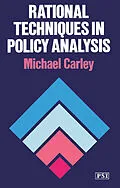Rational Techniques in Policy Analysis covers the role of rational techniques in policy making process. This book is organized into two parts encompassing 12 chapters that consider the relationship of policy making and other approaches to rational analysis.
Part I deals with the "disintegration" of rational policy analysis to find out what the pieces are, how they work, how the parts interact and how they relate to the wider policy making environment. Part II considers the types of rational analysis in more detail, and serves not only as a survey of rational techniques but as an introduction to the important literature in each field. This part specifically looks into the cost-utility techniques, social forecasting, and evaluation and social indicator research.
This book is intended primarily for analysts, researchers, and students of the policy making process in university and government.
Inhalt
List of Figures
Acknowledgments
Preface
Definitions of Terms
Part I
I Introduction
Controversy Abounds
A Balanced Perspective
This Book
2 Analytic Rationality
Rationality: A First Look
The Policy Process and Analytic Rationality
General Problems with the Rational Model
Conclusion
3 Exploring Policy Analysis
Policy Making and Policy Analysis
Essential Value Judgements
The Scope of Policy Analysis
The Value of Rational Analysis
4 A Process Approach to Analysis
The 'Roots' of Analytic Rationality
The Past and the Future in Analysis
The Common Process in Analysis
The Role of the (Rational) Policy Analyst
5 Categories for Rational Techniques
Cost-Utility Analysis
Impact Assessment
Forecasting and Futures Research
Evaluation Research
Social Indicator Research
6 Problem Areas in Analysis
Efficiency and Effectiveness
Pluralism and Implementation in Decision Making
Value Judgements within Analysis
Quantification and Qualification
Aggregation and Value Weighting
Distributional Equity
Public Participation and Analysis
Conclusion
Bibliography: Part I
Part II
7 Cost-Utility Techniques
Measuring Costs and Benefits
Cost-Benefit's Reformist Offspring
Decision Analysis: Preferences and Uncertainty
Conclusion
8 Studying Environmental and Social Impact
Environmental Impact Methodology
Social Impact Assessment
Issues in Impact Assessment
9 Social Forecasting and Futures Studies
Trend Extrapolation
Qualitative Techniques
Dynamic Modeling
Issues in Futures Studies
10 Evaluation Research
Controlled and Quasi Experiments
The Cost-Utility Approach to Evaluation
Performance Measurement
Issues in Evaluation
11 Social Indicator Research
Programmatic Development
Development by Social Goal Area
Development by Life Cycle
Development from a Theoretical Base
Conclusion
12 Postscript
Index
